Hello guys, I am pleased to participate in this weeks' steemitcryptoacademy lessons presented by Prof @allbert on Accumulation and Distribution Indicator. Let's get rolling...

(designed in Canva)

Question 1: Explain in your own words what the A/D Indicator is and how and why it relates to volume. (Screenshots needed).

I can remember vividly Wyckoff's concept of Accumulation and Distribution, a lesson presented by respected Prof @fendit during her days as Prof. This basically tells us the different cycles we have in the market relative to the buy and sell activities which are volume determinants.
A market situation where the Composite Man sees the entire scenarios that happen in the market as a single entity with accumulation, re-accumulation, distribution, and re-distribution being yardsticks to determine the different market trends relative to volume accumulated or distributed at a given period.
The A/D indicator is an all-important indicator that guides the trader on how best to take trade positions relative to expected market cycles controlled by the volume of trade behavior at a given period. Accumulation therein means holders are buying more of a given asset hence there are more buying activities than selling activities.
Whereas in the Distribution scenario we have traders or asset holders selling off accumulated assets which makes selling activities observed more than buying activities in the trade. This simply reminds us of the demand & supply law which tells us that when we have; Demand > Supply = Increasing Price of the asset
Demand < Supply = Decreasing Price of the asset.
At every given market cycle, there is a relative increase in the volume of asset traded (Accumulation) or decrease in volume traded (Distribution). And this guides the trader on possible market trends with possible anticipated market corrections when high volume traded at a given period starts its distribution cycle or low volume traded starts its accumulating cycle. All of this is observed from market high or low point signals that lead to trade positions.
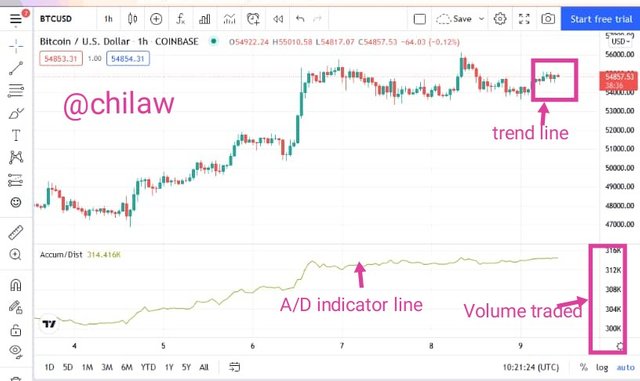
(screenshot from Tradingview site)
From the chart, we can see the price trend on a bull run with volume traded also observed on the increases. Higher volume traded comes with a commensurate price increase verse visa.

Question 2: Through some platforms, show the process of how to place the A/D Indicator (Screenshots needed).

Steps to DD the A/D indicator on a Chart
I will be using the MT5 (Meta Trader 5) just to illustrate how to place the A/D indicator.
- launch the MT5 on your device
- Click on the fx icon the screen
- Search under the volume indicator and click on the Accumulation/Distribution option
- From the Landing interface, we can see the different parameters all set at default . We have the Volumes-Tick, Styles-3pixels, and Levels-1pixel.
- Click on the DONE button to apply the A/D indicator settings on the chart.
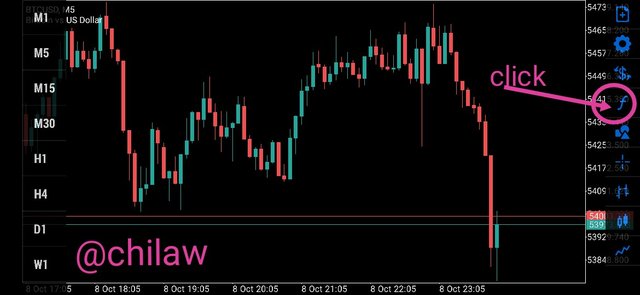
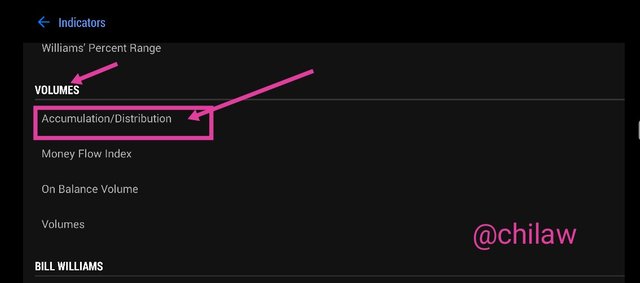
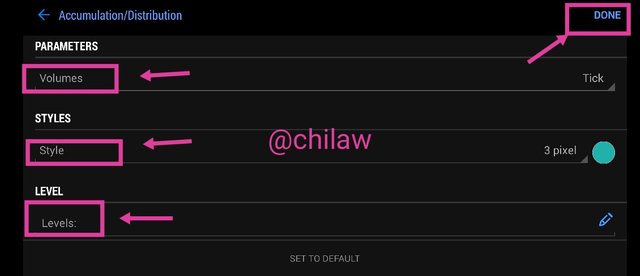
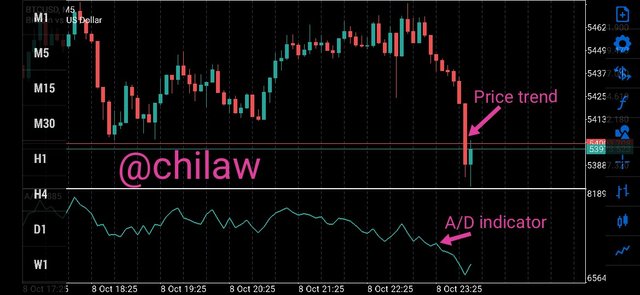
(Screenshots from MT5 Trading Site)

Question 3: Explain through an example the formula of the A/D Indicator. (Originality will be taken into account).

While calculating the A/D indicator, we have to really determine some key values like the Money Flow Multiplier and Money Flow Volume. They are necessary to calculate the A/D of any given asset as a given period.
Money Flow Multiplier (MFM) = (Closing price - Low price in a period) - (High price in a period - Closing price) / (High price -Low Price)
Money Flow Volume (MFV) = Money Flow Multiplier (MFM) * Period Volume
A/D = Previous A/D + Current MFV
I will present a chart for us and make a typical illustration of how to calculate the A/D

(Screenshot from MT5 site)
High Price - 0.06640
Low price - 0.06515
Closing Price - 0.06690
Previous Volume - 3226
Money Flow Mulitplier = (0.06690 - 0.06515) - (0.06640 - 0.06690) / (0.06640 - 0.06515)
Money Flow Multiplier = (0.00175) - (-0.0005) / (0.00125)
Money Flow Multiplier = 0.00225/0.00125
Money Flow Mulitplier (MFM) = 1.8
Money Flow Volume (MFV) = 1.8 * 3226
Money Flow Volume (MFV) = 5,986.8
A/D = 3226 + 5986.8
A/D = 9,212.8

Question 4: How is it possible to detect and confirm a trend through the A/D indicator? (Screenshots needed)

I will be representing this concept in three (3) ways which clearly shows when the market cycle is observed in the Accumulation zone, Distribution zone, and when it Divergent.
Uptrend Confirming the A/D Indicator
During the Accumulation market cycle, there is relatively higher buying pressure with fewer selling activities which makes the price trend demonstrate some bull movements. The A/D indicator is directly seen correlating with price trend and hence an uptrend is observed therein.

Downtrend Confirming the A/D Indicator
This scenario is usually observed during the Distribution Market cycle where accumulated assets are sold off. There is higher selling pressure than the buying activities which have a corresponding downtrend of prices. In this scenario, the A/D indicator is observed to be in a direct correlation with the price trend.

Divergence Trend Confirming the A/D Indicator
This is an entire scenario that sees the price trend in opposite direction with the A/D indicator. One would say that the price trend and the A/D indicator line are not in agreement with their trends. But this happens to be a trade signal for the holder which are expected to anticipate possible trade positions each time we have this occurrence. This can be either bullish or Bearish trend Divergence

(Screenshots from MT5 site)

Question 5: Through a DEMO account, perform one trading operation (BUY or SELL) using the A/D Indicator only. (Screenshots needed).


(screenshot from Tradingview site)
From the chart above, we have a typical representation of the Downtrend as well the Uptrend movements which correlates with the A/D indicator Trends. This simply suggests that we have redistribution which was followed by Accumulation after the price trend got to a strong support level. At this level, we have more buying activities than selling activities. The support level was observed at 53,648 at 312K accumulation level.
An entry order was made at 55,034 with a Risk Reward Ratio set at 1:1. From the chart, we can see that Stop Loss was set at the 53,648 and Take profit was 55,764

Question 6: What other indicator can be used in conjunction with the A/D Indicator. Justify, explain and test. (Screenshots needed).

There is no Indicator that does well alone rather its efficiency is enhanced when combined together. Hence the A/D indicator is also observed to give more effective results when combined to filter out false signals in trade.
we already know that the A/D indicator is a volume indicator and I will be combining it with the Relative Strength Index (RSI) indicator which is a momentum indicator. The RSI indicator should be able to provide details relative to when an asset is overbought or Oversold during Accumulation and Redistribution market cycles.
During market cycles which are basically determined by the volume of assets traded, price trends are observed to either peak at a swing high point (Overbought zone) or peak at a swing low point (Oversold). These signals can be confirmed after a possible and anticipated market correction or Reversal which are veritable points to make trade positions. The RSI indicates these levels by its default settings with periods set 14, Overbought levels at bands 70, and oversold levels at bands 30.

(Screenshot from tradingview site)
From the RSI and A/D indicator above, we can clearly observe that the price trend was seen above the RSI bands 70 which signals overbought levels for assets as well as high traded volume if asset and stronger accumulation. An entry order was taken where there was a valid break with a stronger candlestick observed with a Reward Risk (R: R) Ratio of 2:1.
Trade Analysis
Entry Order - 51,766
Stop Loss (SL) - 50,397
Take Profit (PL) - 54,745

Conclusion

Traders and holders of the asset have found the A/D indicator which is categorized under the Volume indicator as veritable in guiding their trade positions relative to Accumulation and Distribution market cycles. These are levels points that represent asset acquisition which comes with uptrend and price increase as well as depleting of this already accumulated asset which comes with downtrend and decrease in the price of the asset.
The A/D Indicator trend line may also be observed to be Divergent, in this case, there should be anticipated market reversal thereafter. This should be a good signal in positioning the trader to make good trade positions as soon as a valid break with a strong candlestick is observed.
A/D indicator can as well be combined with the RSI indicator for better results and readings. This brings in the overbought and Oversold level points into price movement in relation to the accumulation and distribution zones driven by the demand and supply of traded volume.
Thank you respected prof @allbert, this is my entry to your homework task.